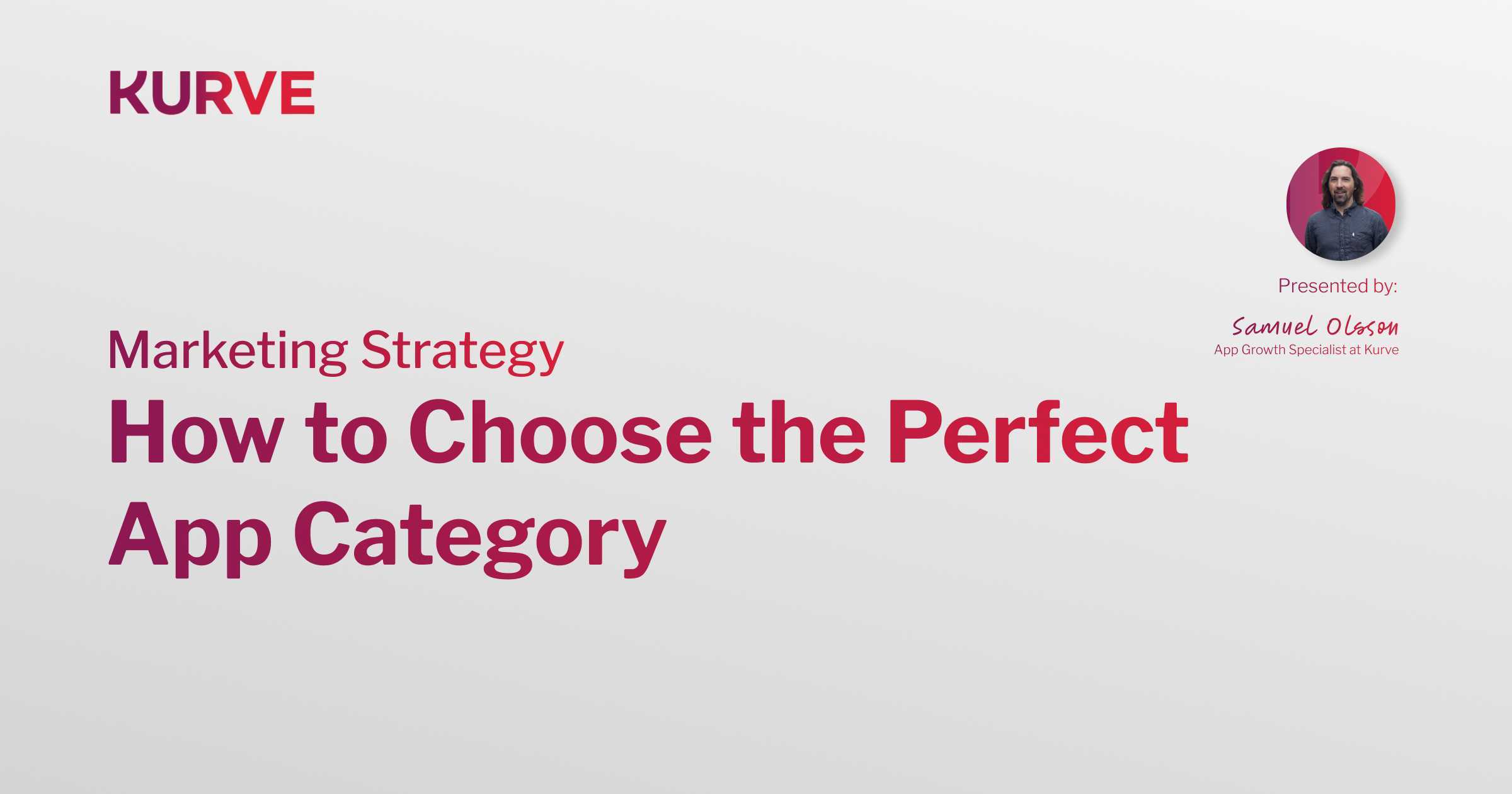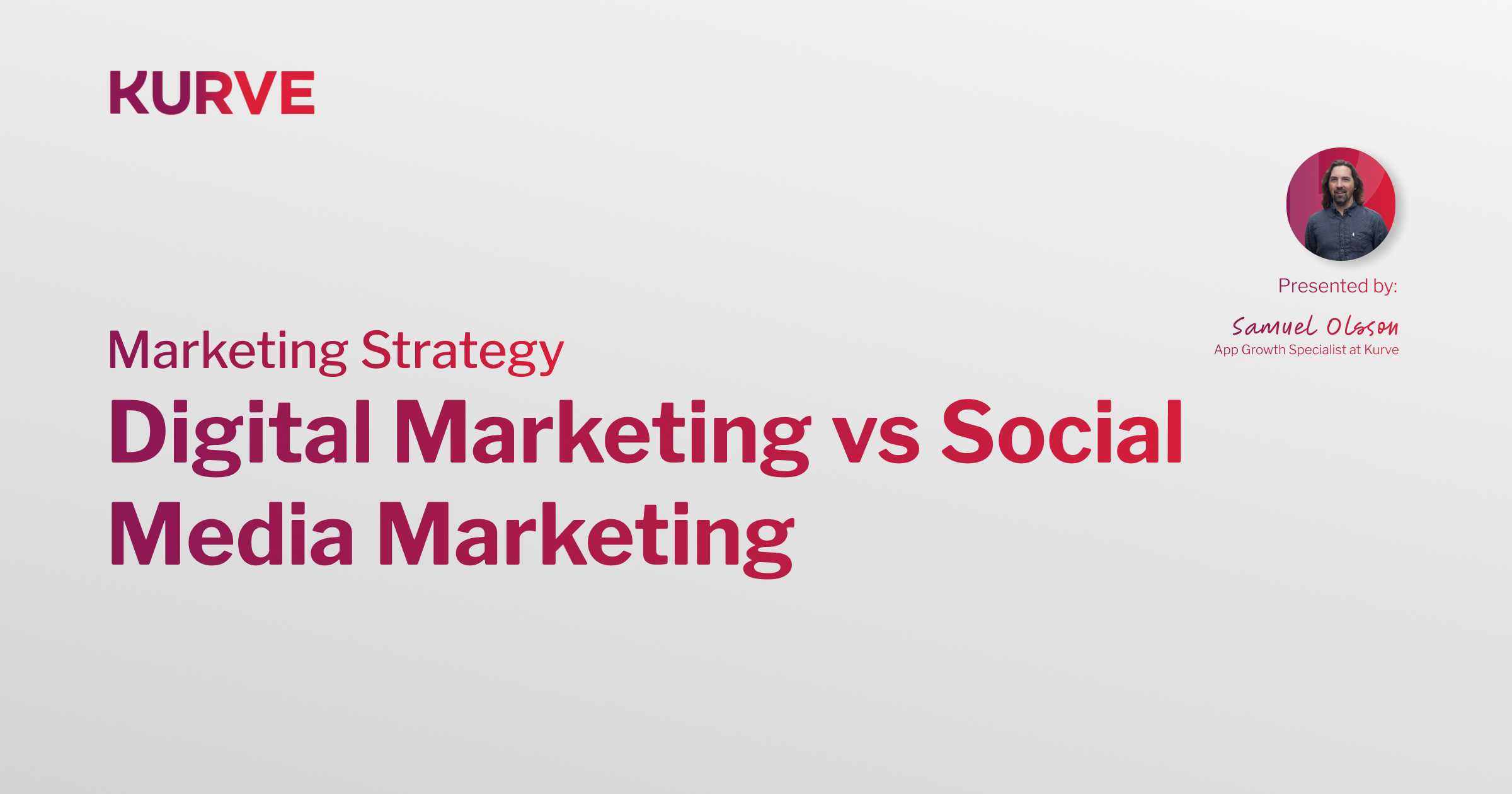What is Mobile App Advertising? Everything You Need to Know
In our digital-first world, mobile app advertising has emerged as an effective way to target mobile device users.
Unlike other forms of digital advertising, it offers a direct platform to engage users with content tailored to preferences and browsing behavior on mobile.
Why focus on mobile users?
Simply put, it's a larger, more engaged audience.
The average person spends several hours on their mobile device daily, allowing advertisers to interact through captivating ads in a personalized and immersive environment.
If you want to learn more about specific strategies for mobile app marketing, check out our previous blog post on the topic. The world of advertising in mobile apps can be intricate, but it's worth understanding the dynamics to build an effective and successful marketing campaign.
What is Mobile App Advertising?
Unlike other forms of digital advertising, mobile app advertising leverages the unrivaled power of mobility.
It's about showcasing your brand on consumers' smartphones, the one digital device that accompanies us everywhere.
The primary goal? Reach and engage with users turning to mobile apps for browsing, shopping, and entertainment needs. Mobile app advertising helps you do precisely that. It's about taking your brand and fitting it into the daily lives of mobile app users.
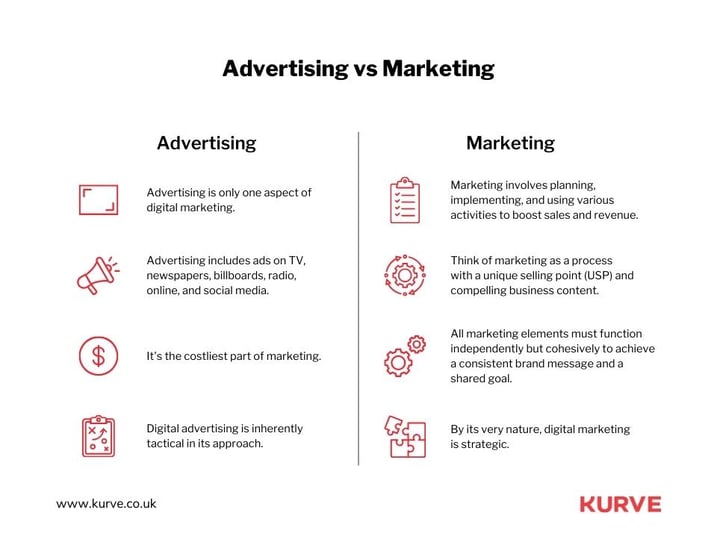
Remember, it's not about reaching people; it's about reaching the right people at the right time. This form of advertising provides enormous benefits for pinpoint targeting, thanks to the wealth of user data at our disposal.
If you're feeling inspired to grasp the specifics of this subject, our comprehensive Mobile App Marketing Strategy guide is just a click away. It dissects each process stage, giving you actionable insights for your journey in the mobile universe.
Benefits and Challenges of Mobile App Advertising
Advertising in mobile apps offers notable benefits to mobile publishers, starting with personalization.
User behavior and preference data allow you to create ads that resonate with your target audience. However, there are challenges like privacy concerns, ad blockers, and in-app ad-blocking features. Standing out within the crowded app ecosystem adds to these challenges.
To tackle these obstacles and leverage the benefits, keeping up with the latest trends is fundamental. One key area to explore is adopting strategic approaches for promoting your app to thrive in this competitive space.
Moreover, effective mobile app advertising can substantially increase your reach. But to promote your mobile app ads, understanding current app marketing trends, like using data-driven strategies and innovative ad formats, can set you on the right path.
To summarize, mobile app advertising success can lead to a tremendous boost in app downloads. This article on getting more app downloads offers actionable tips on driving growth by refining your campaign.
Benefits
Mobile app advertising is no longer just an add-on; it's a power move. It's about putting your products or services in your customer's hands.
Why is it a game-changer?
Well, think about this. As we inch closer to most of the world's population owning smartphones, your business can tap into this increasing connectivity. Mobile advertising gives your brand a cozy spot in your customers' everyday lives. That's what sets it apart from traditional channels.
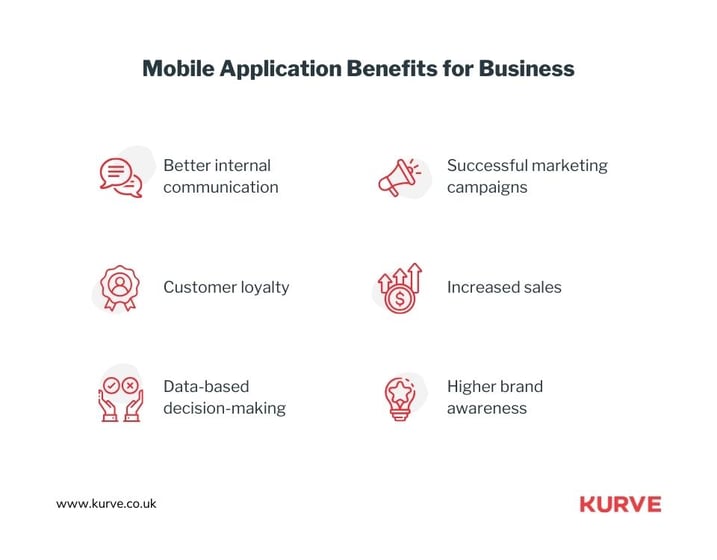
Revenue Generation Potential
How about making a tangible, impactful, and substantial difference to your top line? With mobile advertising, we’re talking precisely that—revenue increments. Because, let’s face it, placing your products or services right where users spend most of their digital time will increase sales.
Consider those in-app purchases or the effect of showcasing recommended items to a user. The probabilities for conversion rise considerably. The icing on the cake? This targeted advertising is more cost-effective and efficient than its traditional counterparts.
Enhanced User Engagement
Why settle for plain attractiveness when interactive ads can significantly push the boundaries to boost user engagement? With every additional interaction heightening the chances of conversion, user engagement is not just a desirable target. It's a game-changer.
Coupling that engagement with personalized ad experiences, rich media, and user-friendly designs, you're not just running an ad campaign. You're orchestrating a unique user experience that captivates and captivates in equal measure.
Targeting the Right Audience
Precision? Check. Relevance? Check. High potential? Double check. Mobile ads have perfected the art of precision targeting so that your ads reach only those who matter to your business: your potential customers.
And when we empower this with data analytics, the refinement in ad targeting takes a quantum leap. Your ads gain the power to leverage geo-targeting and behavior-based algorithms to create relevant and targeted communication like never before
Efficiency
Amid the ebb and flow of online behaviors, mobile adverts appear precisely when users are most likely to engage. Their efficiency is unmatched, and the speedy deployment of mobile ad campaigns makes this an extremely versatile tool.
Moreover, the real-time ability to fine-tune mobile ad network strategies ensures your campaigns stay optimized throughout their lifecycle. You adapt, learn, and improve, refining your strategy every step of the way.
Real-time Performance Tracking
Who wouldn't like to have a bird's eye view of how their ads are performing? Mobile advertising not only offers that but takes it several notches up. With many analytics tools, you can track all vital metrics, leading to data-informed decision-making.
Think of A/B testing and implementing constant improvements based on results. It saves you from shooting in the dark. You're participating in a calculated, scientific, and strategic journey that transforms ad performance and, in turn, your bottom line.
Challenges
While mobile advertising could be your ticket to more ad revenue and increased brand engagement and growth, they're not free of challenges.
Like navigating stormy seas, getting your mobile ad campaigns right requires careful steering, a watchful eye for environmental changes, and a sound strategy.
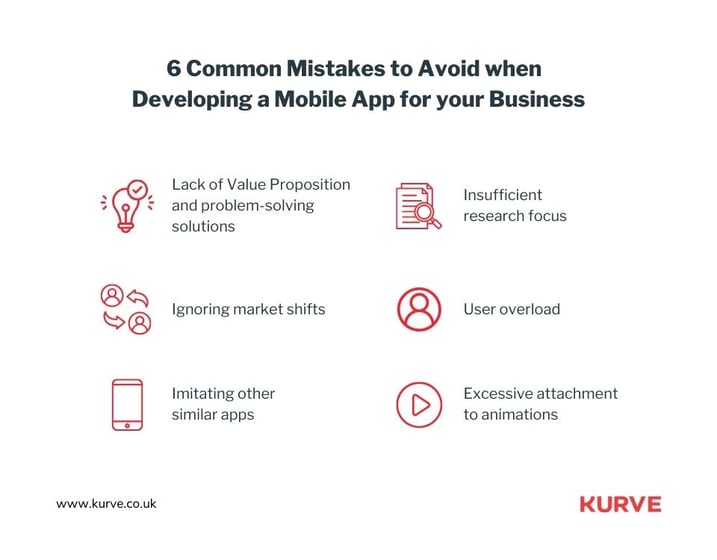
Navigating Ever-Changing Trends
Mobile advertising trends change faster than one can blink. It's crucial to keep your strategy flexible and open to amendments. Failing to catch up with industry shifts can cost you big, like setting a digital stroll when the rest of the industry is sprinting.
Risk of Ad Fatigue
Now, here's a bummer – some ad networks get fatigued. That's when users see your ad too many times and stop caring. It's like an overplayed song on the radio. To hold onto your audience's attention on ad networks, you'll need to mix it up a bit to avoid bombarding users with the same old advert.
Ensuring Quality and Avoiding Accidental Clicks
The importance of quality can't be overstated. A well-designed ad can turn into accidental clicks, making the user frustrated and unlikely to engage. This reminds us again why user experience is king in the world of mobile ads. Quality targeting, design, and placement make for successful mobile ad campaigns.
7 Effective Strategies for Mobile App Advertising
After a deep dive into the benefits and challenges of mobile app advertising, it's time to transition into actionable steps.
At Kurve, we empower you with practical, proven mobile app advertising strategies you can act on immediately. Our seasoned experts have curated a list of seven effective tactics for mobile app advertising.
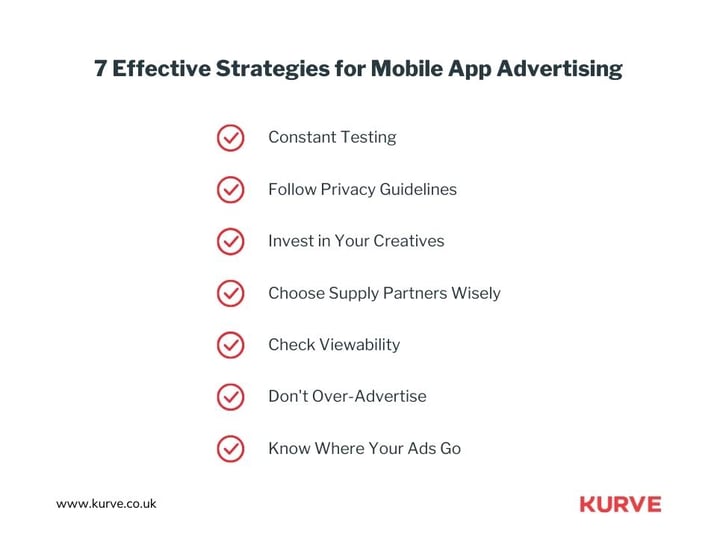
Each strategy is tried, tested, and proven in the marketplace. These strategies will boost your advertising effort and help transform how you connect with your audience.
However, we know mobile app advertising and user acquisition can be complex. That's why we've also detailed these strategies in our comprehensive guide to mobile app growth strategy. It's there to build on your understanding further, offering in-depth insights, tips, and tactics for accelerating your mobile app growth.
Constant Testing
Testing and fine-tuning play a key role. As a comparison tool for ad components, A/B testing is invaluable. Progress is all about using the feedback effectively and making data-backed improvements.
Follow Privacy Guidelines
Privacy guidelines are more than legal jargon. They symbolize your commitment to user security. Following all rules and being transparent builds trust. And trust forms the bedrock of any long-lasting user relationship.
Invest in Your Creatives
Well-executed creatives can pique user interest. They love quality design and content. It drives engagement. With robust creatives, you can generate more than clicks. You can create memorable experiences.
Check Viewability
Viewability is to be noticed. An exceptional ad delivers no value if unseen. So, check that your paid ads will have high visibility. As rates increase, so do the chances of a successful campaign.
Don't Over-Advertise
Over-advertising? Skip it. Users appreciate a well-tuned ad frequency. More ads can lead to quick uninstalls. Regularly adjust ad frequency based on user feedback. Balance is key.
Know Where Your Ads Go
Your ads need to be in the right place. Knowing where your ads go is a crucial component of your strategy. Your choice of ad platform can influence campaign effectiveness. Stick with reputable platforms to safeguard your reach.
Choose Supply Partners Wisely
Partnering with reliable ad suppliers adds another layer of success to your campaign. A thorough vetting process ensures you collaborate with professionals, prioritize quality, and maintain a robust reputation for your advertising efforts.
These tried-and-true tactics are not simple tips but are guiding pillars for your mobile app advertising success. Adopt them, adapt them, and witness the positive impact on your campaigns.
How to Measure Mobile App Advertising Success
Running successful mobile app advertising campaigns doesn't end with strategizing and implementation. The next crucial step is to measure your success. Like a reward waiting at the end of an extended mission, getting your hands on complex data can reveal how well your strategies have played out.
One key factor in measuring your mobile advertising's success is knowing what key performance indicators (KPIs) to track. These metrics offer a clear picture of your campaign's trajectory, pointing out where you've hit the bulls-eye and where you need to make adjustments.
And here at Kurve, we believe in data-driven marketing. You can visit this article to see why this approach is value-packed. It's a hub of insights from our past success with our clients.
We'll now break down each of these metrics, providing a comprehensive picture of how you can gauge your advertising success.

Click-Through Rate (CTR)
Click-Through Rate (CTR) is a critical metric in mobile app advertising. It is the ratio of users who click on an ad to the total number of users who have viewed the ad or impressions.
CTR measures user interest. High CTR suggests the ad grabs attention and motivates users to engage. It also indicates ad relevance, showing the message matches users' interests or needs.
Conversion Rate
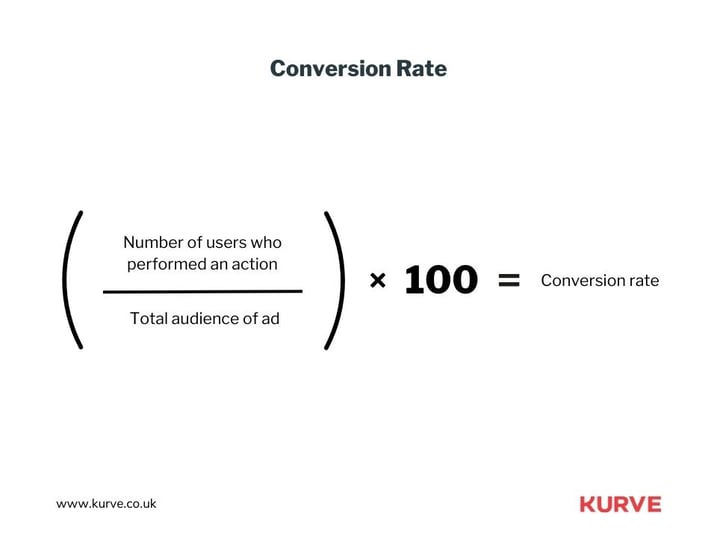
In mobile web and app advertising, we define Conversion Rate as the percentage of users who take a desired action after clicking on an ad.
Conversion Rate is crucial. It indicates whether an ad campaign is achieving its end goal. A higher Conversion Rate generally means a successful campaign, whether it's driving app downloads, sign-ups, or purchases.
Cost Per Click (CPC)
.jpg?width=717&height=560&name=Cost%20Per%20Click%20(CPC).jpg)
CPC, or Cost Per Click, is the amount you pay each time a user clicks on your advertisement.
CPC holds significance in budgeting and calculating Return on Investment (ROI). Tracking CPC can help you understand how much each engagement with your advertising is costing you. Therefore, it provides a guiding point for adjusting your ad budget and strategies.
Cost Per Conversion (CPCV)
Cost Per Conversion (CPCV) is a metric that allows us to see the cost of each conversion generated through the ad campaign. It plays a critical role in evaluating the financial effectiveness of a campaign.
Companies can plan their budgets by understanding how much it costs to bring every new user or customer aboard. A low CPCV can indicate advertising success and signal the marketing strategy's need for further scaling or course corrections.
Return on Ad Spend (ROAS)
.jpg?width=717&height=560&name=Return%20on%20Ad%20Spend%20(ROAS).jpg)
Return on Ad Spend, or ROAS, is a key performance indicator in advertising. It is calculated as the revenue generated from an ad campaign divided by the campaign cost.
Quantifying ROAS allows companies to evaluate the profitability of their ad campaigns. This metric is essential for understanding the return on advertising investment, enabling businesses to make informed decisions on marketing spend, optimize their advertising strategies, and maximize returns.
Ad Impressions
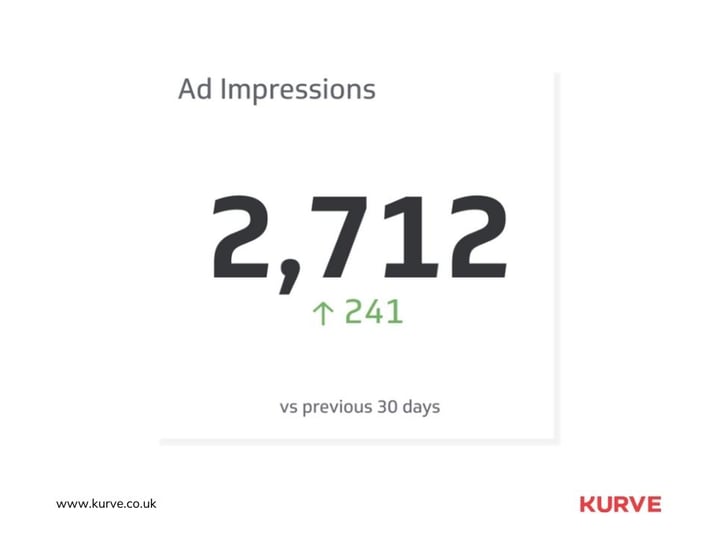
Ad Impressions measure the count of times an ad is fetched and displayed, irrespective of user engagement, such as clicking. This metric is about assessing the reach of an ad campaign.
By tracking Ad Impressions, businesses can better understand their brand visibility and potential market reach. A high number of impressions generally indicates increased brand awareness, which can contribute to an improved overall advertising strategy. Monitoring impressions also provides critical data for potential optimizations and fine-tuning campaign targeting.
Engagement Rate
.jpg?width=717&height=560&name=Ad%20Impressions%20(2).jpg)
Engagement rate is a fundamental metric in advertising. It measures the extent of user interaction with an ad. This could include video ad views, social shares, or clicks within the ad.
Marketing is about reaching and engaging as many people as possible. Monitoring the engagement rate helps us identify what resonates with our audience. It serves as an indicator of both user interest and the overall effectiveness of an ad.
Lifetime Value (LTV)
.jpg?width=717&height=560&name=Lifetime%20Value%20(LTV).jpg)
Lifetime Value (LTV) is a crucial metric in understanding the long-term worth of a converted user. It represents a customer's projected revenue throughout their relationship with the business.
By calculating the LTV, we can effectively assess the potential financial benefit of acquiring new customers versus retaining existing ones. This knowledge dictates our marketing strategies, pricing models and investment decisions, ultimately driving sustainable growth.
Ad Fatigue
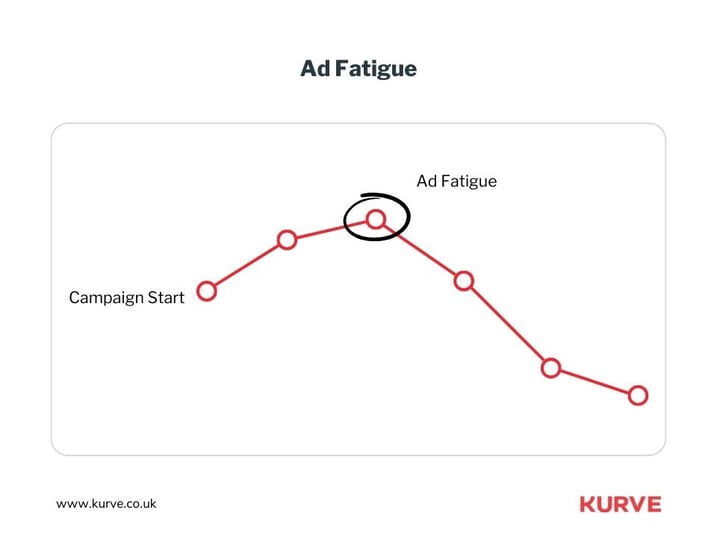
Ad fatigue is when consumers become less responsive to ads due to repeatedly seeing similar ads. It's a critical concept for advertisers to bear in mind.
Continuous analysis of engagement metrics can help us spot signs of ad fatigue early. This way, we can refresh our ad creative or adjust the target audience to prevent diminishing returns from repeated ad displays. It's about ensuring our messaging stays fresh, relevant, and impactful.
Viewability
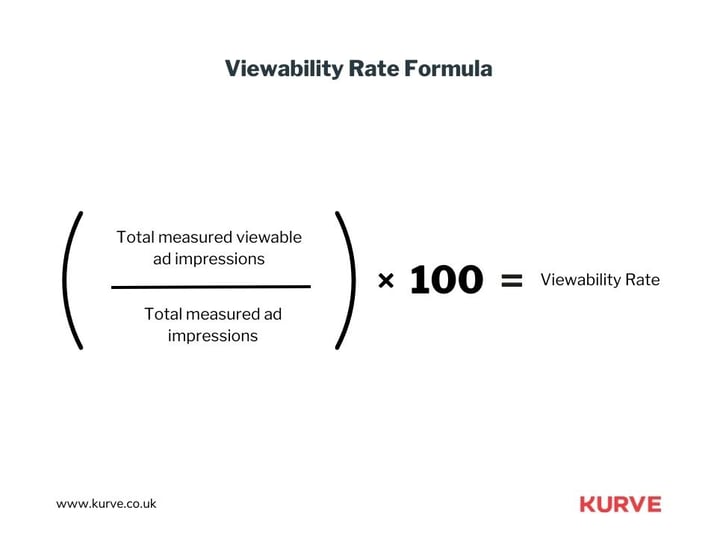
Viewability refers to whether a user can see an ad or not. Ensuring our clients' spending on ads translates into actual visibility is vital.
A high viewability rate indicates that our adverts appear where they are likely to be seen. It allows us to boost the effectiveness of our ad campaigns, ensuring that we create opportunities for engagement and conversion.
The Power of Mobile App Advertising
There's no doubting it: Mobile app advertising is brimming with potential.
It's a pathway for businesses to connect with their target audience. At its core, it's about increasing user engagement and opening up new avenues of ad revenue.
Still, as with any robust strategy, challenges are bound to pop up. The key is to rise above these hurdles, employing strategies that adapt and evolve as needed.
What's clear is that advertising in mobile apps can be a transformational tool for brands. At Kurve, we encourage businesses to realize the magnitude of this shift. The pivot toward a more mobile-focused approach isn't a promise of growth -- it delivers it.
For further insights on mobile app marketing, please use our blog. It's a haven of knowledge, with strategies to leverage for exponential your app business growth.

